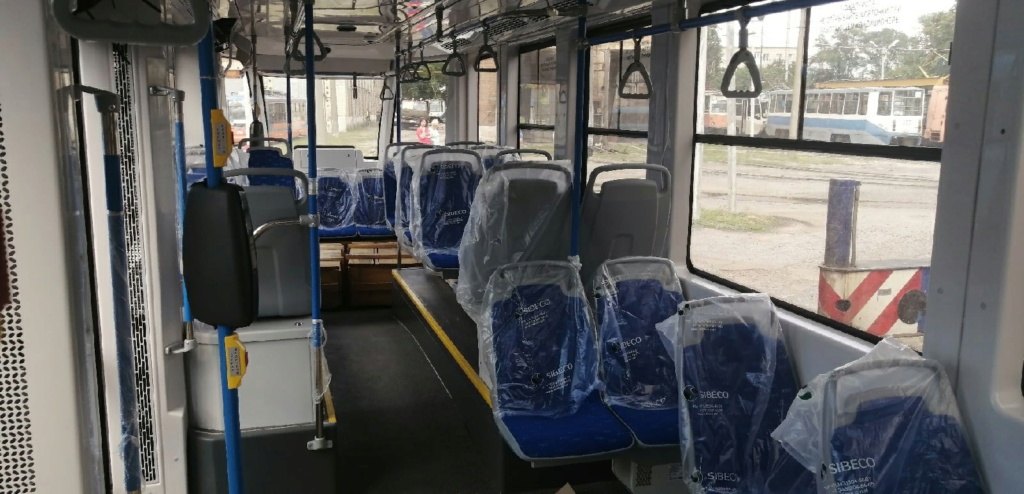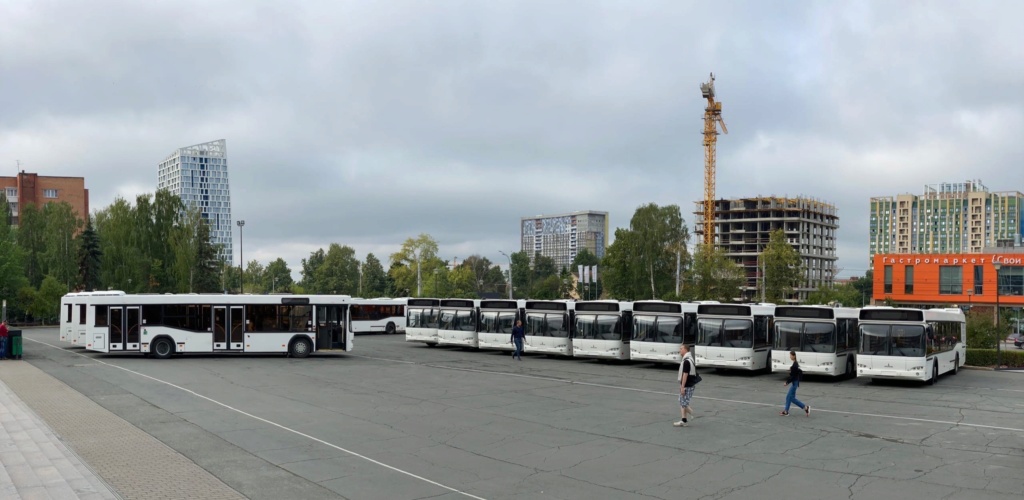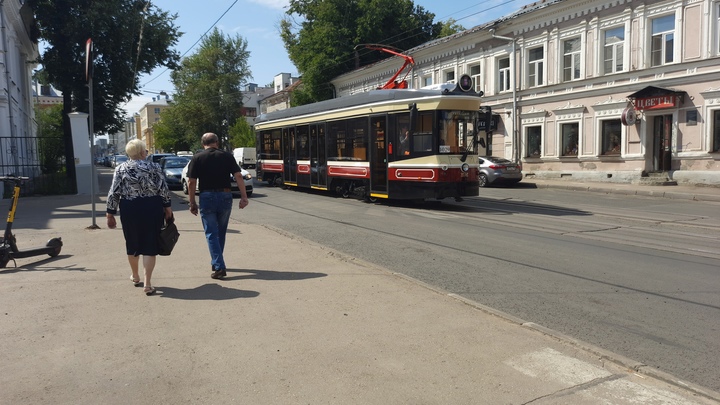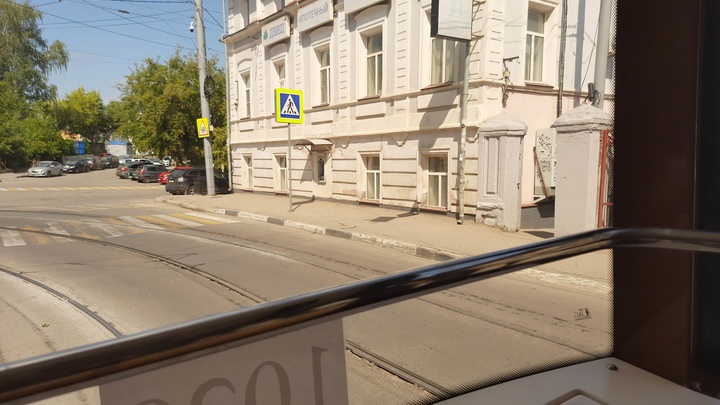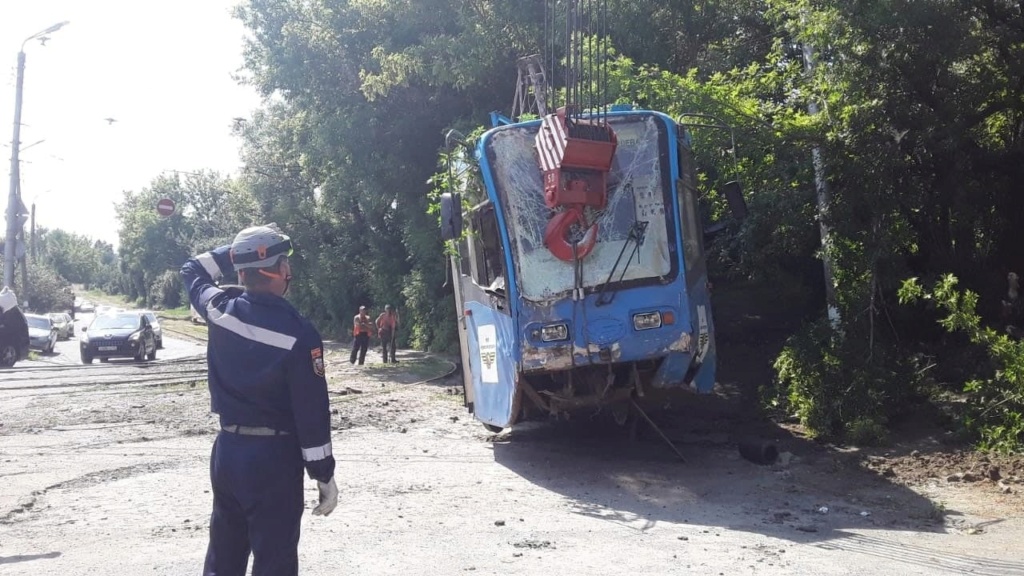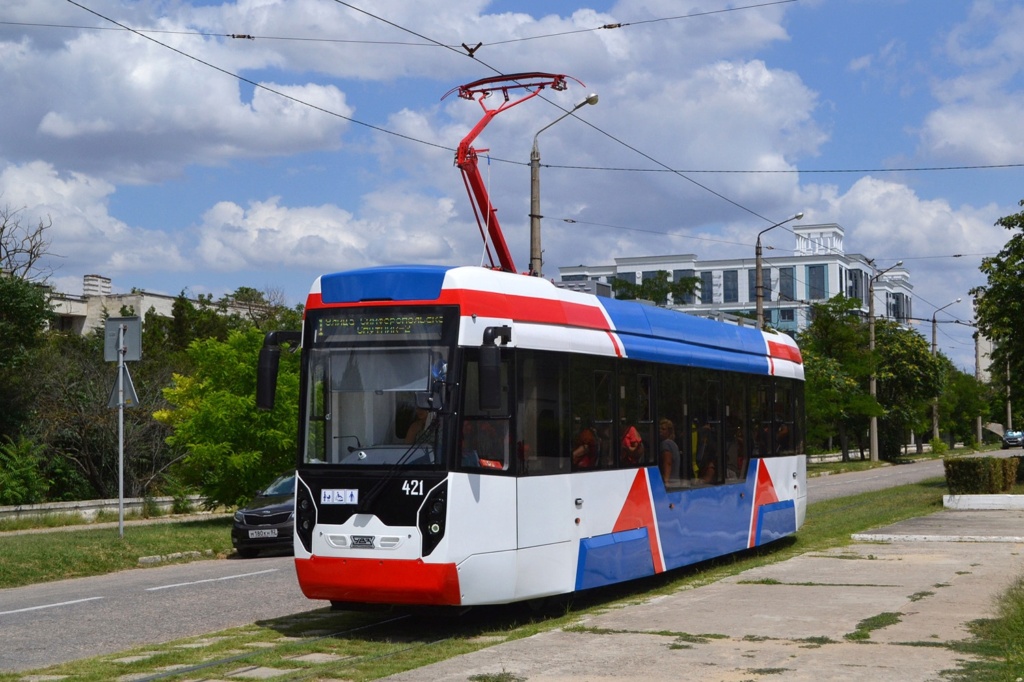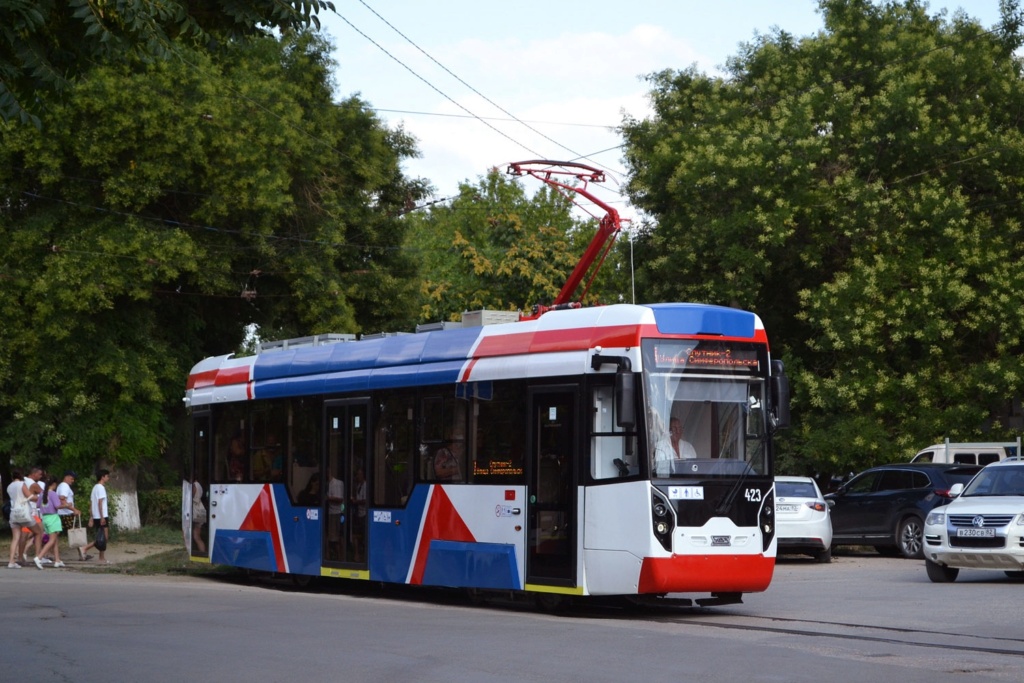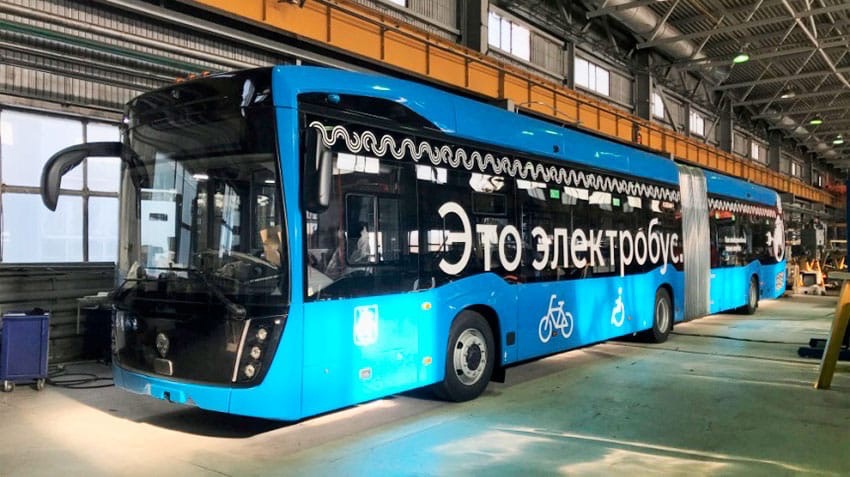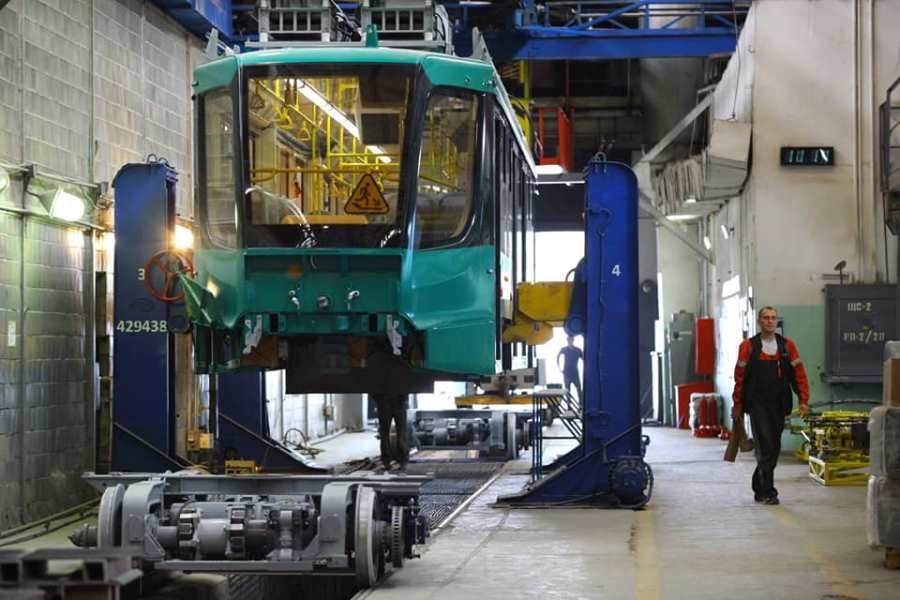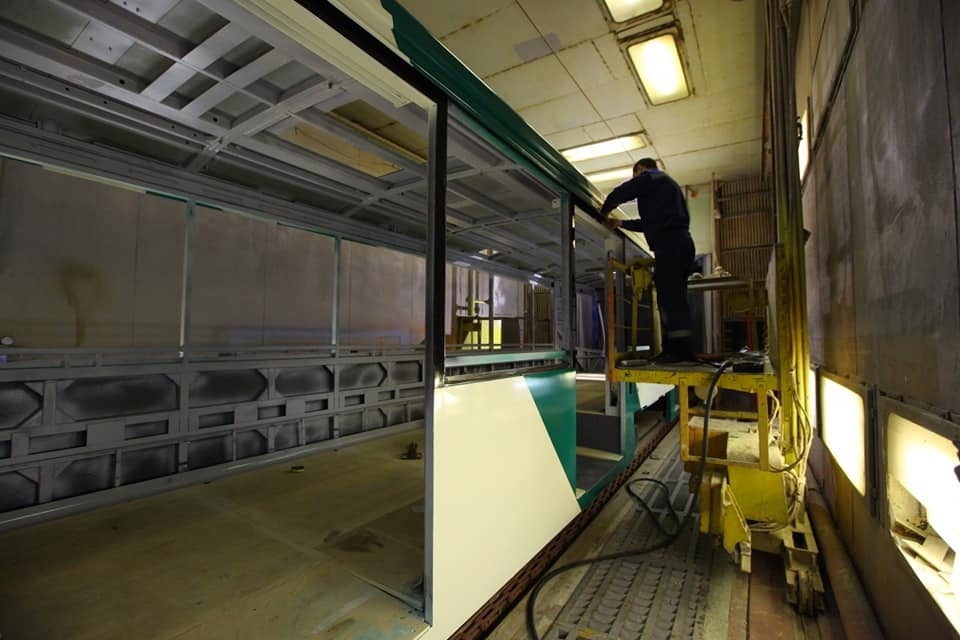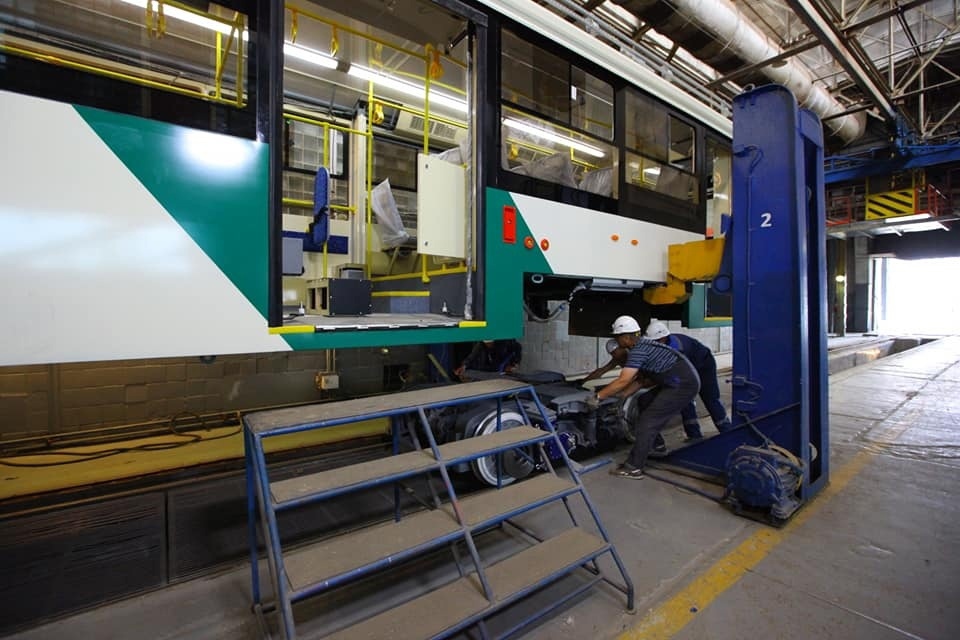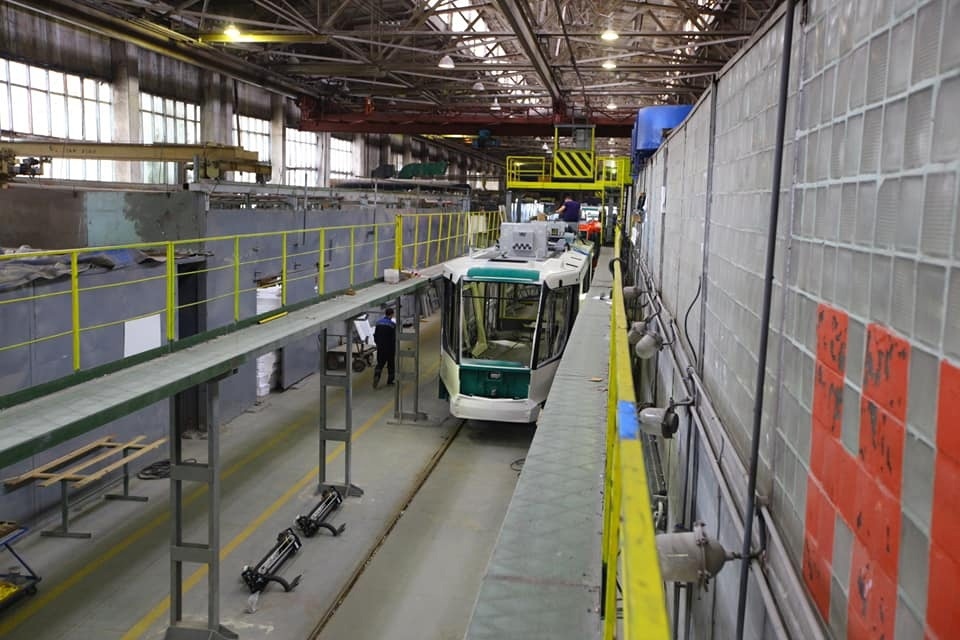+7
Kiko
kvs
Russian_Patriot_
Big_Gazza
ALAMO
GarryB
flamming_python
11 posters
Public transport in Russian cities

Russian_Patriot_- Posts : 1286
Points : 1300
Join date : 2021-06-08
- Post n°1
 Public transport in Russian cities
Public transport in Russian cities
This is a topic for discussion of Russian public transport. Public transport in Russian cities is very important, but after the collapse of the USSR, it was in decline for a long time. Although now large cities are equipped with modern transport (low floor, air conditioners, electronic displays, phone chargers and sometimes even Wi-Fi), the situation in the Russian outback is not comforting, although there is a positive trend.
dino00 and owais.usmani like this post

Russian_Patriot_- Posts : 1286
Points : 1300
Join date : 2021-06-08
GarryB, flamming_python, dino00, xeno and kvs like this post

flamming_python- Posts : 9519
Points : 9577
Join date : 2012-01-30
Russian_Patriot_ wrote:The first new tram model 71-628 produced by UKVZ arrived in Taganrog. In total, the city should receive 60 new cars. Most likely, many people do not know, but the city is carrying out a complete replacement of tram tracks and trams themselves with new ones
Lots of cities are. Or a major upgrade and expansion of them
In the Soviet-era, metros were earmarked for cities that reached 1 million population
These days under market conditions, it's recognized that metro systems are not really worth the cost unless a city reaches closer to 5 million people. In Russia, there are no such cities outside of Moscow and St. Petersburg.
You do have cities of 1-2 million though, where metros were constructed in the Soviet-era already, and for this reason are still in operation and being expanded. These are the metros in Kazan, Nizhny Novgorod, Novosibirsk, Samara and Ekaterinburg. A lot of them run half-empty or otherwise a long way below capacity. But they've been constructed already, so might as well be used.
As for the 80s-90s planned projects of metros for all other +1 million size cities, almost all of them have been cancelled and instead now they're going for the speed tram route as a mass-transit alternative for these cities
Speed trams are so called because they run on sections of roads sectioned off from or otherwise inaccessible to auto-transport, rather than sharing the roads with them as you might normally see trams do in old European cities or San Francisco or some such (and in Russia as well). Sectioning them off separately allows them to run at much higher speeds. Usually this section occupies the middle of a wide road, or branches off into a side-route. They're widely seen in the suburbs of European cities and lately Russian cities as well.
The speed tram system is quite perspective I would think for medium-size cities of 250,000-900,000 people or so, such as Taganrog, or functioning as an auxiliary form of transport for large metropolis cities such as Moscow & St. Petersburg (where you can find them as well in the suburbs)
Yet there is another innovation here as well. In Russia, for cities at or over 1 million people, these speed trams, while running on roads further away from the center, will also have underground stations closer to the city center, so as to not take up space on narrower and more congested central roads.
There was already such a system built in Volgograd in the Soviet era. The trams have their own underground stations in the city centre, and further away from it they have ground-level stops or stations and simply run on sectioned off sections of roads or on their own paths.
Now, such systems are earmarked for or already being constructed in Ufa, Saratov-Engels, Rostov-on-Don, Omsk, Chelyabinsk and Perm
Such a system is called a metrotram. In practice it functions like a shallower, lower-capacity and slower version of a full-fledged metro system. But it's a lot less expensive to construct and maintain, and also a lot more flexible - trams can seamlessly transition from tunnels to running on roads adjacent to traffic, and back again.
The only new metro system planned/under construction in Russia, is in Krasnoyarsk. The city only has about 1.1 million people, but is projected to be the 2nd most major city in Siberia (after Novosibirsk) in the future. I think the key factor here is its geography. The city is basically equally situated on two sides of a river and within a sort of shallow ravine. This all necessitates deep tunnels, and it's easier to manage all this with just a normal metro system.
GarryB and Russian_Patriot_ like this post

GarryB- Posts : 40516
Points : 41016
Join date : 2010-03-30
Location : New Zealand
We had trains and trams here but the got rid of them... someone made lots of money...
They often talk about bringing back trams but nothing ever happens.
Should be clear Dunedin is very hilly so trams make sense on the hills and allowing people to get around easily without having to bring a car.
Often being electric the trams would make more sense than just using buses which sometimes have problems manouvering around certain tight corners that were not designed with such big vehicles in mind.
Much of the town area is covered in bicycle lanes which I think are a total waste of time and money because they are not used most of the time.
There is a real shortage of carparks in town as it is so being able to get around on something that does not take up parks, that older people or people with mobility problems can use would be a very useful thing.
I am very pleased to see all this work in Russian cities to make things better... that is what it should all be about, not bombing countries and overthrowing regimes.
They often talk about bringing back trams but nothing ever happens.
Should be clear Dunedin is very hilly so trams make sense on the hills and allowing people to get around easily without having to bring a car.
Often being electric the trams would make more sense than just using buses which sometimes have problems manouvering around certain tight corners that were not designed with such big vehicles in mind.
Much of the town area is covered in bicycle lanes which I think are a total waste of time and money because they are not used most of the time.
There is a real shortage of carparks in town as it is so being able to get around on something that does not take up parks, that older people or people with mobility problems can use would be a very useful thing.
I am very pleased to see all this work in Russian cities to make things better... that is what it should all be about, not bombing countries and overthrowing regimes.

Russian_Patriot_- Posts : 1286
Points : 1300
Join date : 2021-06-08
UKVZ plans to build a new assembly shop for the production of trams.
The general director of UKVZ, Roman Novikov, in an interview with Pravda UrFO, spoke about the plans to expand the production capacity of the plant: "We really faced the problem of lack of capacity. Some of the equipment is outdated – it is difficult to achieve perfect quality on it. Moreover, the production of components on it requires a lot of time and effort. Already this year, we have invested 100 million rubles in new machines. This will allow us to expand production and cope with the execution of all our plans. Approximately in November-December, the machines will start working, which will allow us to add both quality and speed. In addition, it was decided to build a new assembly shop with a feed front for 22 tram cars. We will build the building from scratch, purchase modern equipment, which will allow us to become the best in Russia in terms of the production of tram cars. We plan to implement this project in a year. We have agreed on a budget of about a billion rubles. By the new year, we want to lay the foundations and start the main work in the spring. An open competition will be held soon, at which we will choose contractors who will build and supply equipment. Thanks to the new project, we will not only maintain the existing staff of 2.8 thousand people, but also expect to create about 200 new high-performance jobs for residents of Ust-Katav and surrounding settlements."
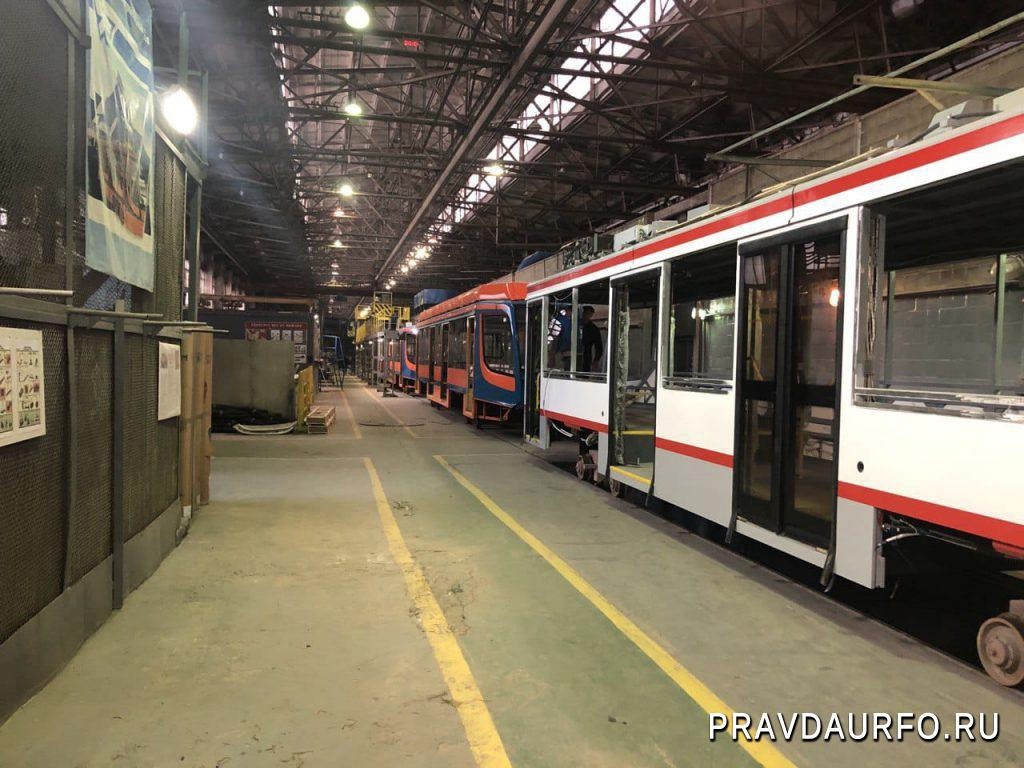
The general director of UKVZ, Roman Novikov, in an interview with Pravda UrFO, spoke about the plans to expand the production capacity of the plant: "We really faced the problem of lack of capacity. Some of the equipment is outdated – it is difficult to achieve perfect quality on it. Moreover, the production of components on it requires a lot of time and effort. Already this year, we have invested 100 million rubles in new machines. This will allow us to expand production and cope with the execution of all our plans. Approximately in November-December, the machines will start working, which will allow us to add both quality and speed. In addition, it was decided to build a new assembly shop with a feed front for 22 tram cars. We will build the building from scratch, purchase modern equipment, which will allow us to become the best in Russia in terms of the production of tram cars. We plan to implement this project in a year. We have agreed on a budget of about a billion rubles. By the new year, we want to lay the foundations and start the main work in the spring. An open competition will be held soon, at which we will choose contractors who will build and supply equipment. Thanks to the new project, we will not only maintain the existing staff of 2.8 thousand people, but also expect to create about 200 new high-performance jobs for residents of Ust-Katav and surrounding settlements."


Russian_Patriot_- Posts : 1286
Points : 1300
Join date : 2021-06-08

Russian_Patriot_- Posts : 1286
Points : 1300
Join date : 2021-06-08
GarryB and Big_Gazza like this post

Russian_Patriot_- Posts : 1286
Points : 1300
Join date : 2021-06-08
UKVZ will produce 180 trams for 7 billion rubles by the end of 2022.
In an interview with Pravda UrFO, the general director of UKVZ Roman Novikov told about the current orders of the plant: "180 tram cars have already been contracted – this is about 7 billion rubles until the end of 2022. For at least the last 15 years, the plant has not done such a volume. On average, this is 120 cars per year. Trams for Moscow, Taganrog, and Chelyabinsk are currently in operation. In July, we completed the execution of the contract for Krasnodar. I believe that in 2021 we will have a profit. We have accelerated well, all departments are involved in the work. In terms of revenue last year, we had about 1.9 billion rubles. Now we are talking about more than 5.4 billion rubles, and in 2022 we expect to reach 5.7 billion."
Trams:
For Taganrog
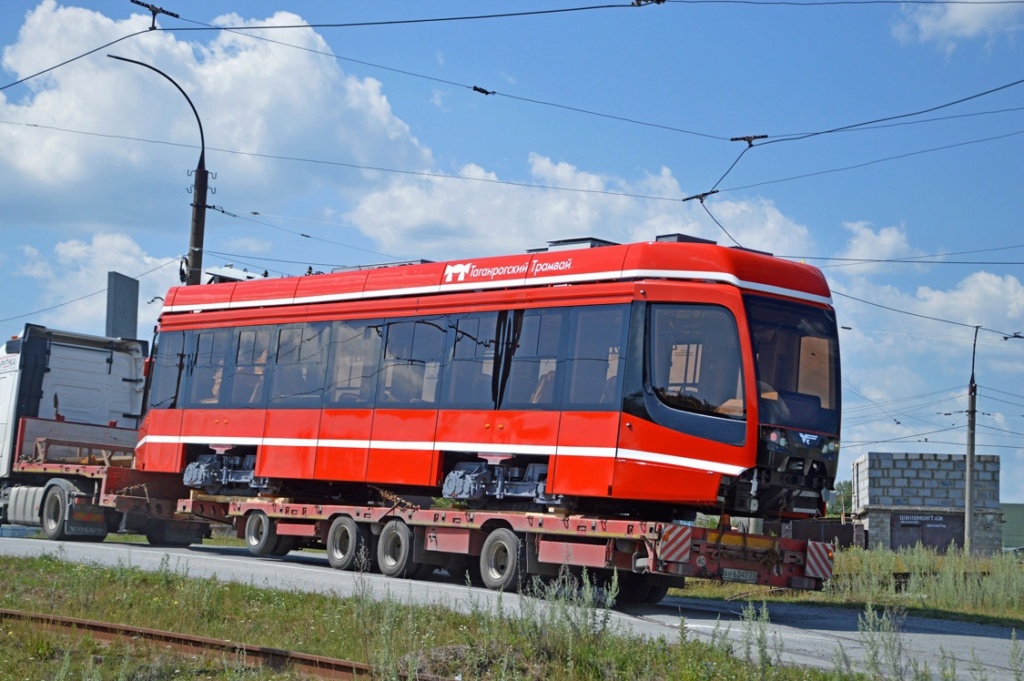
For Chelyabinsk
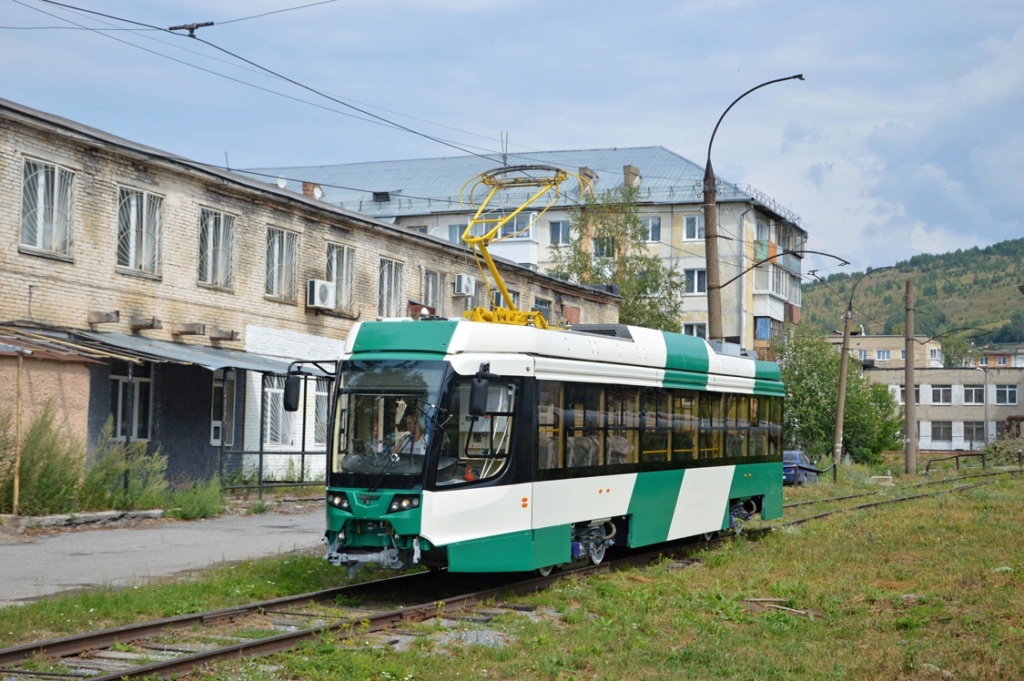
For Novokuznetsk
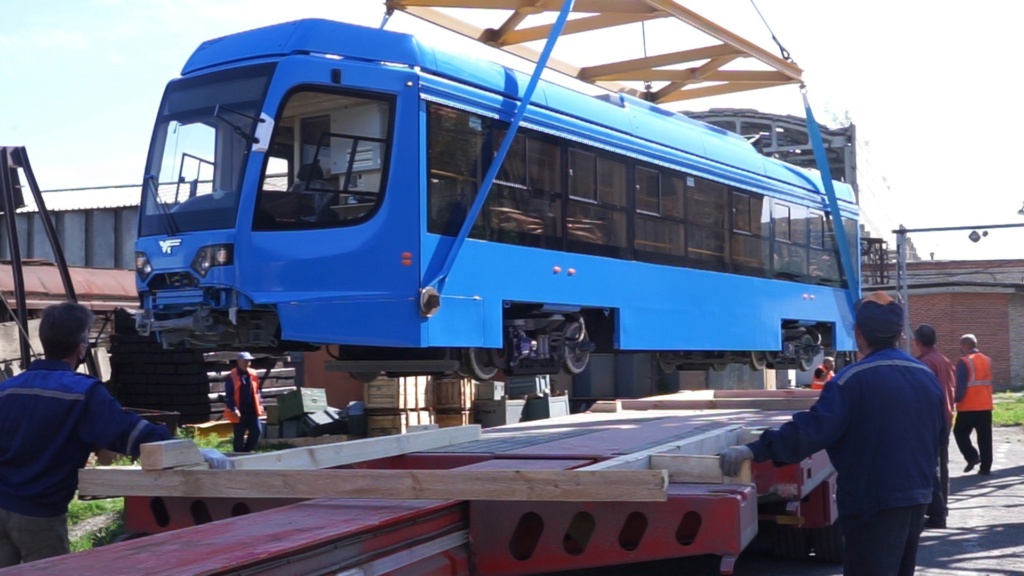
For Krasnodar
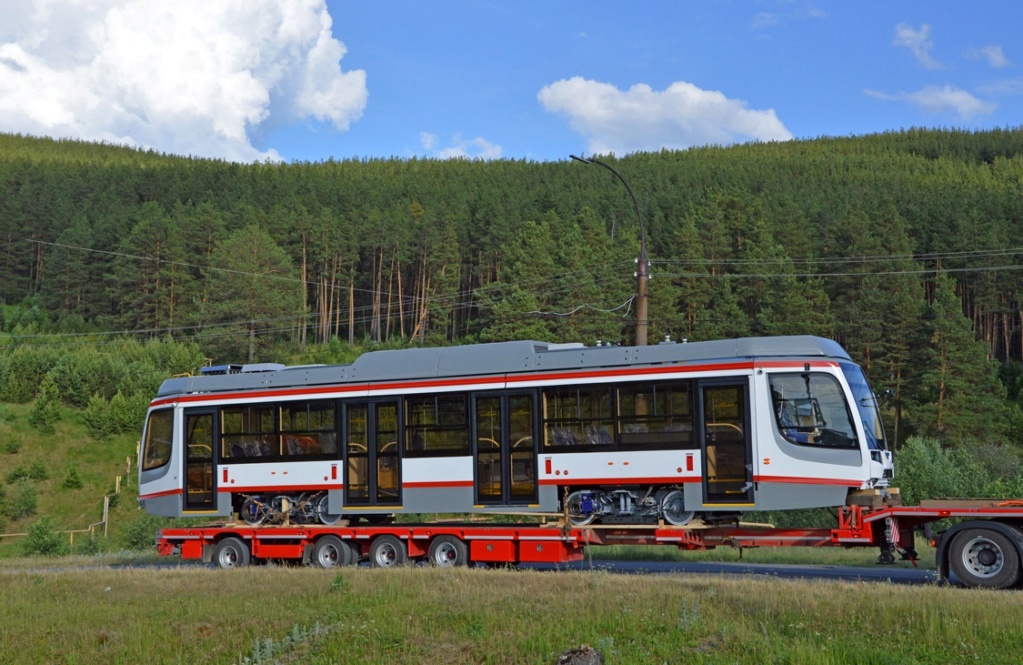
In an interview with Pravda UrFO, the general director of UKVZ Roman Novikov told about the current orders of the plant: "180 tram cars have already been contracted – this is about 7 billion rubles until the end of 2022. For at least the last 15 years, the plant has not done such a volume. On average, this is 120 cars per year. Trams for Moscow, Taganrog, and Chelyabinsk are currently in operation. In July, we completed the execution of the contract for Krasnodar. I believe that in 2021 we will have a profit. We have accelerated well, all departments are involved in the work. In terms of revenue last year, we had about 1.9 billion rubles. Now we are talking about more than 5.4 billion rubles, and in 2022 we expect to reach 5.7 billion."
Trams:
For Taganrog

For Chelyabinsk

For Novokuznetsk

For Krasnodar

GarryB and Tingsay like this post

ALAMO- Posts : 7470
Points : 7560
Join date : 2014-11-25
Russian_Patriot_ wrote:The first of 11 retro-style trams has entered the regular route in Nizhny Novgorod
Fantastic!
I am old enough to remember the same style of trams in my own city.
The wooden bench makes me nostalgic
Those were replaced by old trams from 60s, imported from Germany in mid-90s only.
The old German stuff get a common name "Helmut", and served well for years, too

flamming_python- Posts : 9519
Points : 9577
Join date : 2012-01-30
- Post n°10
 Re: Public transport in Russian cities
Re: Public transport in Russian cities
Another thing I heard was a Russian institute currently experimenting with Maglev carriages, for use as a mass-transit system in cities
They're promising models to go out to some cities for testing soon
It's not well known, but in the Soviet-era a test Maglev transit system was built in Armenia. It was decommissioned in the 90s
Pretty interesting though. No moving parts means much less wear & tear, and therefore maintenance costs. It also means minimal vibration for the customers no matter at what speeds it travels. Much more steady than a tram or metro train.
Not as flexible as a tram though, as the tracks have to be magnetized with electromagnets, and the whole construction needs to be protected to some degree. So we can imagine maglev tracks either underground in tunnels or above ground in the form of a monorail setup.
They're promising models to go out to some cities for testing soon
It's not well known, but in the Soviet-era a test Maglev transit system was built in Armenia. It was decommissioned in the 90s
Pretty interesting though. No moving parts means much less wear & tear, and therefore maintenance costs. It also means minimal vibration for the customers no matter at what speeds it travels. Much more steady than a tram or metro train.
Not as flexible as a tram though, as the tracks have to be magnetized with electromagnets, and the whole construction needs to be protected to some degree. So we can imagine maglev tracks either underground in tunnels or above ground in the form of a monorail setup.
GarryB and Russian_Patriot_ like this post

Russian_Patriot_- Posts : 1286
Points : 1300
Join date : 2021-06-08
- Post n°11
 Re: Public transport in Russian cities
Re: Public transport in Russian cities
Wow, I haven't heard of this. I hope that these will really be working prototypesflamming_python wrote:Another thing I heard was a Russian institute currently experimenting with Maglev carriages, for use as a mass-transit system in cities
They're promising models to go out to some cities for testing soon

flamming_python- Posts : 9519
Points : 9577
Join date : 2012-01-30
- Post n°12
 Re: Public transport in Russian cities
Re: Public transport in Russian cities
Russian_Patriot_ wrote:Wow, I haven't heard of this. I hope that these will really be working prototypesflamming_python wrote:Another thing I heard was a Russian institute currently experimenting with Maglev carriages, for use as a mass-transit system in cities
They're promising models to go out to some cities for testing soon
I found the source again (was also published in TASS)
https://lenta.ru/news/2021/02/17/maglev/
So it's from the research institute responsible for developing the Bulava SLBM
They've nearly finished making a prototype and are readying to put it through its paces
The work is being carried out on the basis of the basis of the monorail system (maybe the Moscow Monorail?). So what they're talking about is using light Maglev trains/carriages as an urban mass transit system, rather than an inter-city bullet train as in China and Japan.
And then they're hoping for this Maglev monorail system to be serially produced for various cities around the country
I think it would be a good fit for cities rapidly growing in population and expected to reach 1 million within the next 15 years, or otherwise strategically located next to other countries and getting lots of investment to become future metropolises. Instead of say the speed tram or metrotram systems.
So Kaliningrad, Vladivostok, Makhachkala and Tyumen maybe
GarryB and Russian_Patriot_ like this post

Russian_Patriot_- Posts : 1286
Points : 1300
Join date : 2021-06-08
- Post n°13
 Re: Public transport in Russian cities
Re: Public transport in Russian cities
GarryB likes this post

Big_Gazza- Posts : 4889
Points : 4879
Join date : 2014-08-25
Location : Melbourne, Australia
- Post n°14
 Re: Public transport in Russian cities
Re: Public transport in Russian cities
Russian_Patriot_ wrote:The first of 11 retro-style trams has entered the regular route in Nizhny Novgorod
I live in Melbourne, one of the very few Western nation cities that still have trams in the city center. It's good to see Nizhny Novgorod (and other Russian cities) investing in these great forms of city transport

GarryB and Russian_Patriot_ like this post

Russian_Patriot_- Posts : 1286
Points : 1300
Join date : 2021-06-08
- Post n°15
 Re: Public transport in Russian cities
Re: Public transport in Russian cities
After the collapse of the Soviet Union, the tram infrastructure in Russia has been degraded for more than two decades. Over the past 5 years, you can see a kind of "tram renaissance" in RussiaBig_Gazza wrote:I live in Melbourne, one of the very few Western nation cities that still have trams in the city center. It's good to see Nizhny Novgorod (and other Russian cities) investing in these great forms of city transport
GarryB and Big_Gazza like this post

ALAMO- Posts : 7470
Points : 7560
Join date : 2014-11-25
- Post n°16
 Re: Public transport in Russian cities
Re: Public transport in Russian cities
Big_Gazza wrote:
I live in Melbourne, one of the very few Western nation cities that still have trams in the city center. It's good to see Nizhny Novgorod (and other Russian cities) investing in these great forms of city transport
It is the opposite.
There are trams in Paris, Berlin, Vienna, Lisbon, Barcelona, Warsaw, Prague, Rome, Bratislava, Budapest, Brussel, Basel ...
I am talking only about the ones I saw in my own eyes.
If there are trams in the capital, you can bet there will be some in other big cities, too.
flamming_python and Russian_Patriot_ like this post

Russian_Patriot_- Posts : 1286
Points : 1300
Join date : 2021-06-08
- Post n°17
 Re: Public transport in Russian cities
Re: Public transport in Russian cities
PC Transport Systems has delivered all 40 Lionet trams to Moscow.
PC Transport Systems (PCTS), a leading Russian developer and manufacturer of urban electric transport, has handed over the last units of the 71-911EM Lionet single-floor trams to the Moscow Metro State Unitary Enterprise. Thus, the company fully fulfilled part of the contract, delivering 40 single-section trams to Moscow in 4.5 months.
"The rate of renewal of rolling stock of urban public transport in Moscow is very high, and this is good news, as the quality of transport services is growing" – Felix Vinokur, President of PC Transport Systems says – "The Lionets have been able to blend harmoniously into the city landscape and I am sure that they will soon become the capital's hallmark along with Vityaz-Moscow."
Since May of this year, Lionets have entered the routes of the Krasnopresnenskaya tram network in addition to the Vityazes already familiar to Muscovites. Having all the advantages of more spacious counterparts, they differ only in passenger capacity – 155 people and 40 seats. Thus, the tram is designed for less busy routes or work outside rush hours. Today, trams of this model run in the north and north-west of the capital and have already received high ratings from passengers.
The Lionet became the first single-section trams to arrive in Moscow in the last eight years. The exterior design is designed specifically for the capital of Russia — to form a unified image of Moscow trams. The exterior of the Lionet is very similar to the Vityaz-Moscow — it also has contour lighting of the car, as in the three-section trams delivered in 2021. The mask is equipped with LED light elements in the form of a single whole structure of the front headlights (block lights).
All-glass doors are illuminated green when opened and red when closed. Special photo sensors installed in the doors detect the presence of passengers in the opening, increase the energy efficiency of the tram and eliminate repeated opening and closing of doors.
Lionet's salon is ergonomic and spacious. It provides 40 comfortable console-type seats, USB sockets for charging mobile devices, and state-of-the-art media complexes with the ability to broadcast high-definition images. For the convenience of people with limited mobility, a folding wheelchair ramp and a driver's call button are integrated from the outside. The "talking city" system is integrated for visually impaired passengers. A comfortable and pleasant trip at any time of the year is made by modern quiet and powerful climate control systems.
The interior of the tram is made using aluminum alloys-this increases wear resistance and reduces the fire load of the passenger compartment. The Lvenok tram provides interactive control, an outdoor video monitoring system for passenger boarding and disembarkation zones and monitoring the traffic situation, as well as active and passive driver assistance systems.
All 40 new single-section trams from PC Transport Systems have already been delivered to the Krasnopresnenskoye depot. The last car ordered arrived yesterday. These are trams of a new generation. They are adapted for passengers with limited mobility and are generally very good: they have a climate control system, USB and TYPE-C connectors for charging gadgets, and multimedia screens. We have received 40 new railcars ahead of schedule and are launching them almost 3 months earlier than planned. This is a comfortable and modern transport system that replaces outdated trams in the north and north-west of Moscow. The new cars are completely low-floor and convenient for all passengers to enter and exit. In total, we plan to receive more than 100 trams this year.
Recall that in September 2020, PC Transport Systems won a competition for the production and supply of 114 trams for Moscow. We are talking about 74 three-section trams Vityaz-Moscow and 40 single-section models Lionet.
Today, there are 399 Vityaz-Moscow trams in the Moscow tram park. In the autumn of 2019, the company fully fulfilled the contract for the supply of 300 71-931M Vityaz-M tramcars in 2 years, 6 months and 6 days, which is recorded in the Russian and European Book of Records as the largest number of three-section trams delivered under one contract to one city. In December 2020, PC CU completed the delivery of 90 units of equipment under the supplementary agreement one month ahead of schedule.
Source:

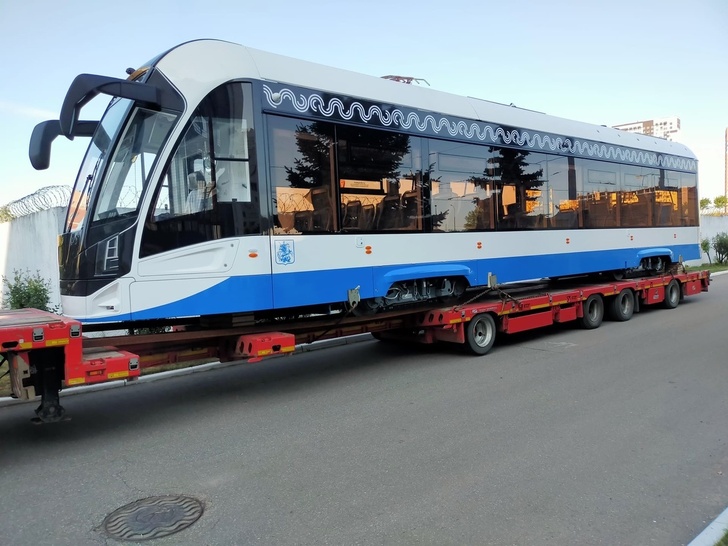
PC Transport Systems (PCTS), a leading Russian developer and manufacturer of urban electric transport, has handed over the last units of the 71-911EM Lionet single-floor trams to the Moscow Metro State Unitary Enterprise. Thus, the company fully fulfilled part of the contract, delivering 40 single-section trams to Moscow in 4.5 months.
"The rate of renewal of rolling stock of urban public transport in Moscow is very high, and this is good news, as the quality of transport services is growing" – Felix Vinokur, President of PC Transport Systems says – "The Lionets have been able to blend harmoniously into the city landscape and I am sure that they will soon become the capital's hallmark along with Vityaz-Moscow."
Since May of this year, Lionets have entered the routes of the Krasnopresnenskaya tram network in addition to the Vityazes already familiar to Muscovites. Having all the advantages of more spacious counterparts, they differ only in passenger capacity – 155 people and 40 seats. Thus, the tram is designed for less busy routes or work outside rush hours. Today, trams of this model run in the north and north-west of the capital and have already received high ratings from passengers.
The Lionet became the first single-section trams to arrive in Moscow in the last eight years. The exterior design is designed specifically for the capital of Russia — to form a unified image of Moscow trams. The exterior of the Lionet is very similar to the Vityaz-Moscow — it also has contour lighting of the car, as in the three-section trams delivered in 2021. The mask is equipped with LED light elements in the form of a single whole structure of the front headlights (block lights).
All-glass doors are illuminated green when opened and red when closed. Special photo sensors installed in the doors detect the presence of passengers in the opening, increase the energy efficiency of the tram and eliminate repeated opening and closing of doors.
Lionet's salon is ergonomic and spacious. It provides 40 comfortable console-type seats, USB sockets for charging mobile devices, and state-of-the-art media complexes with the ability to broadcast high-definition images. For the convenience of people with limited mobility, a folding wheelchair ramp and a driver's call button are integrated from the outside. The "talking city" system is integrated for visually impaired passengers. A comfortable and pleasant trip at any time of the year is made by modern quiet and powerful climate control systems.
The interior of the tram is made using aluminum alloys-this increases wear resistance and reduces the fire load of the passenger compartment. The Lvenok tram provides interactive control, an outdoor video monitoring system for passenger boarding and disembarkation zones and monitoring the traffic situation, as well as active and passive driver assistance systems.
All 40 new single-section trams from PC Transport Systems have already been delivered to the Krasnopresnenskoye depot. The last car ordered arrived yesterday. These are trams of a new generation. They are adapted for passengers with limited mobility and are generally very good: they have a climate control system, USB and TYPE-C connectors for charging gadgets, and multimedia screens. We have received 40 new railcars ahead of schedule and are launching them almost 3 months earlier than planned. This is a comfortable and modern transport system that replaces outdated trams in the north and north-west of Moscow. The new cars are completely low-floor and convenient for all passengers to enter and exit. In total, we plan to receive more than 100 trams this year.
Recall that in September 2020, PC Transport Systems won a competition for the production and supply of 114 trams for Moscow. We are talking about 74 three-section trams Vityaz-Moscow and 40 single-section models Lionet.
Today, there are 399 Vityaz-Moscow trams in the Moscow tram park. In the autumn of 2019, the company fully fulfilled the contract for the supply of 300 71-931M Vityaz-M tramcars in 2 years, 6 months and 6 days, which is recorded in the Russian and European Book of Records as the largest number of three-section trams delivered under one contract to one city. In December 2020, PC CU completed the delivery of 90 units of equipment under the supplementary agreement one month ahead of schedule.
Source:



Russian_Patriot_- Posts : 1286
Points : 1300
Join date : 2021-06-08
- Post n°18
 Re: Public transport in Russian cities
Re: Public transport in Russian cities

Russian_Patriot_- Posts : 1286
Points : 1300
Join date : 2021-06-08
- Post n°19
 Re: Public transport in Russian cities
Re: Public transport in Russian cities
flamming_python likes this post

Russian_Patriot_- Posts : 1286
Points : 1300
Join date : 2021-06-08
- Post n°20
 Re: Public transport in Russian cities
Re: Public transport in Russian cities
The governor of the Rostov region Vasily Golubev visited the tram and trolleybus depot of Taganrog, where the first new tram car was delivered a few days ago.
The head of the region appreciated the comfort and convenience of the new tram. The low floor level will provide ease of movement around the cabin, and large doorways and wide aisles between the rows are convenient for moving small groups of passengers and children. It is noteworthy that the tram is equipped with sockets for charging mobile phones. The cabin is equipped with video surveillance cameras, auto-informators, screens with running lines and multimedia screens, as well as climate control systems. There are 33 seats in the tram, and it can accommodate 116 people in total. "The updated public transport will certainly help to increase the attractiveness of Taganrog as a tourist center" – Vasily Golubev said.
As part of the modernization of the tram network Taganrog, which is implemented by the company "Sinara", 60 new trams will come on the line. The first ten will be delivered in September, the remaining 50 will arrive before the end of October 2022.
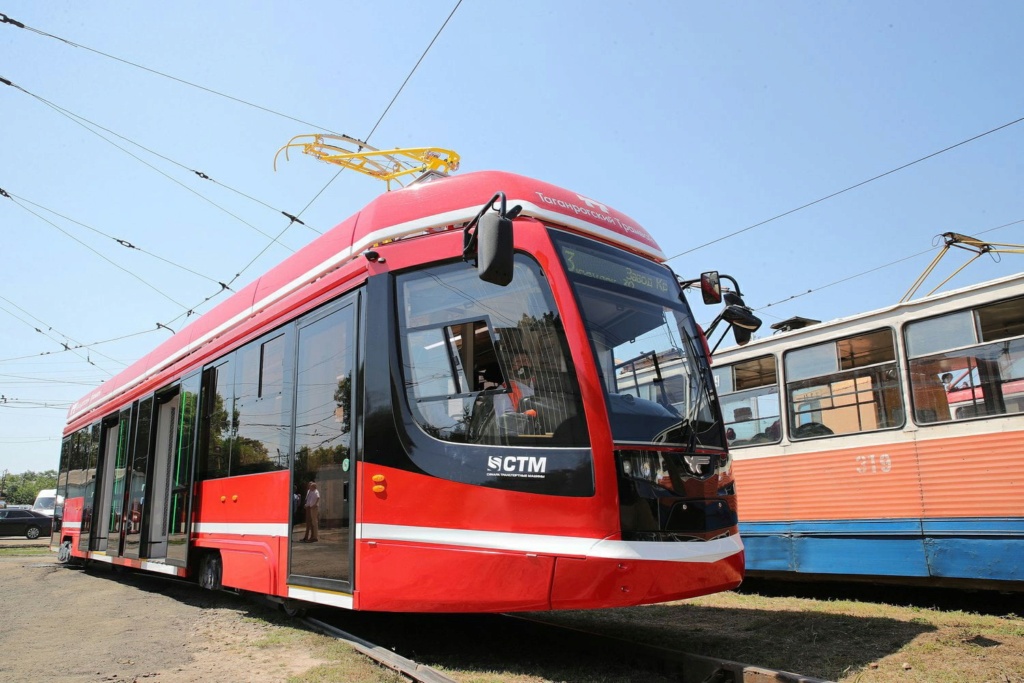
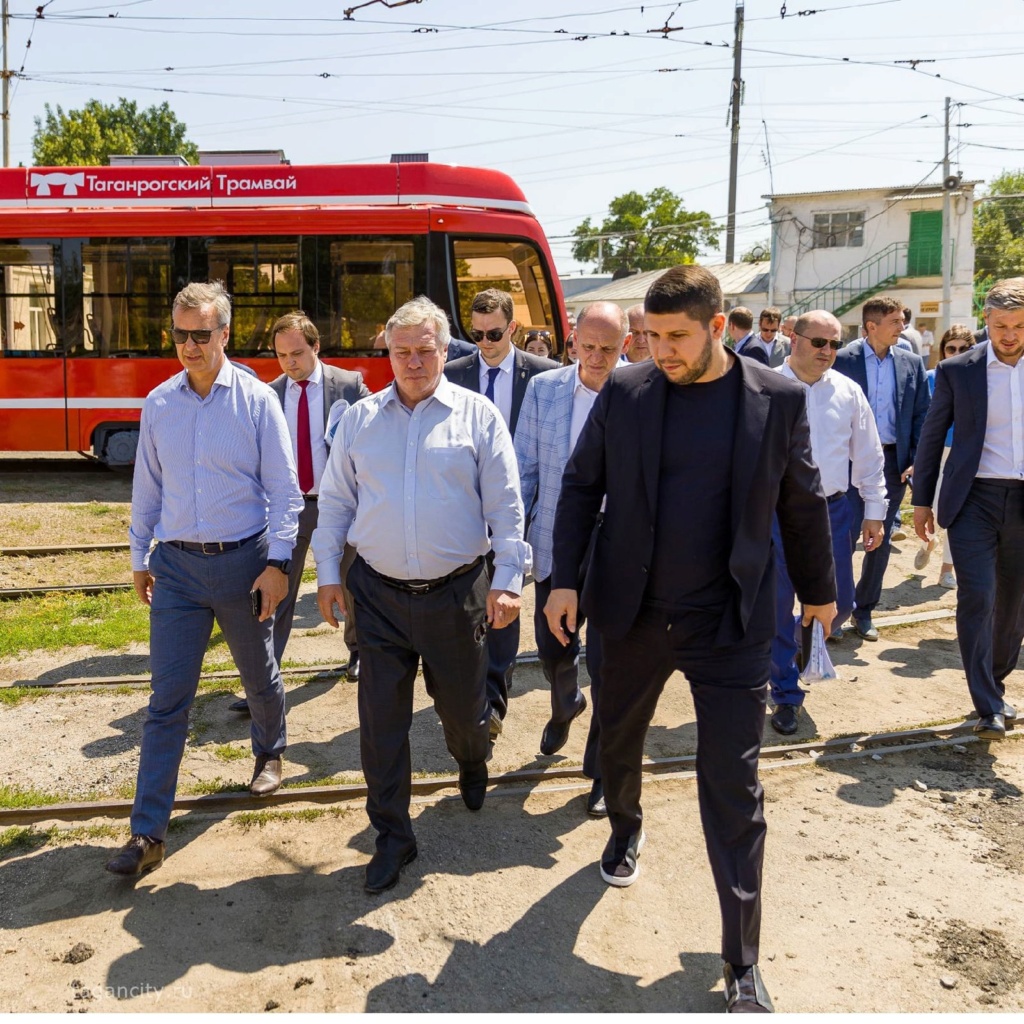
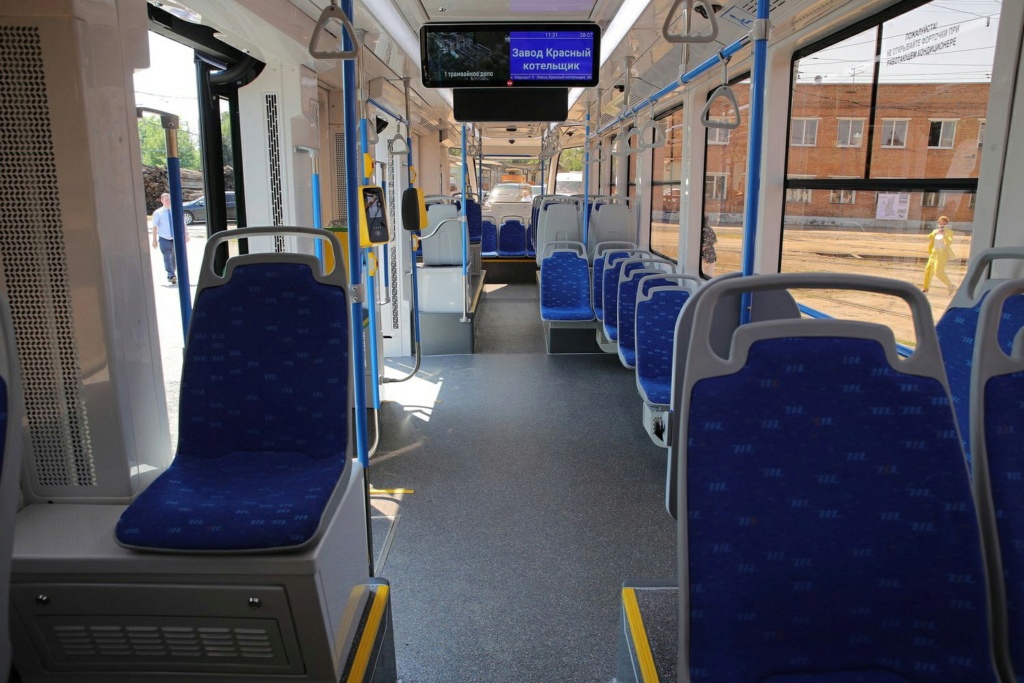
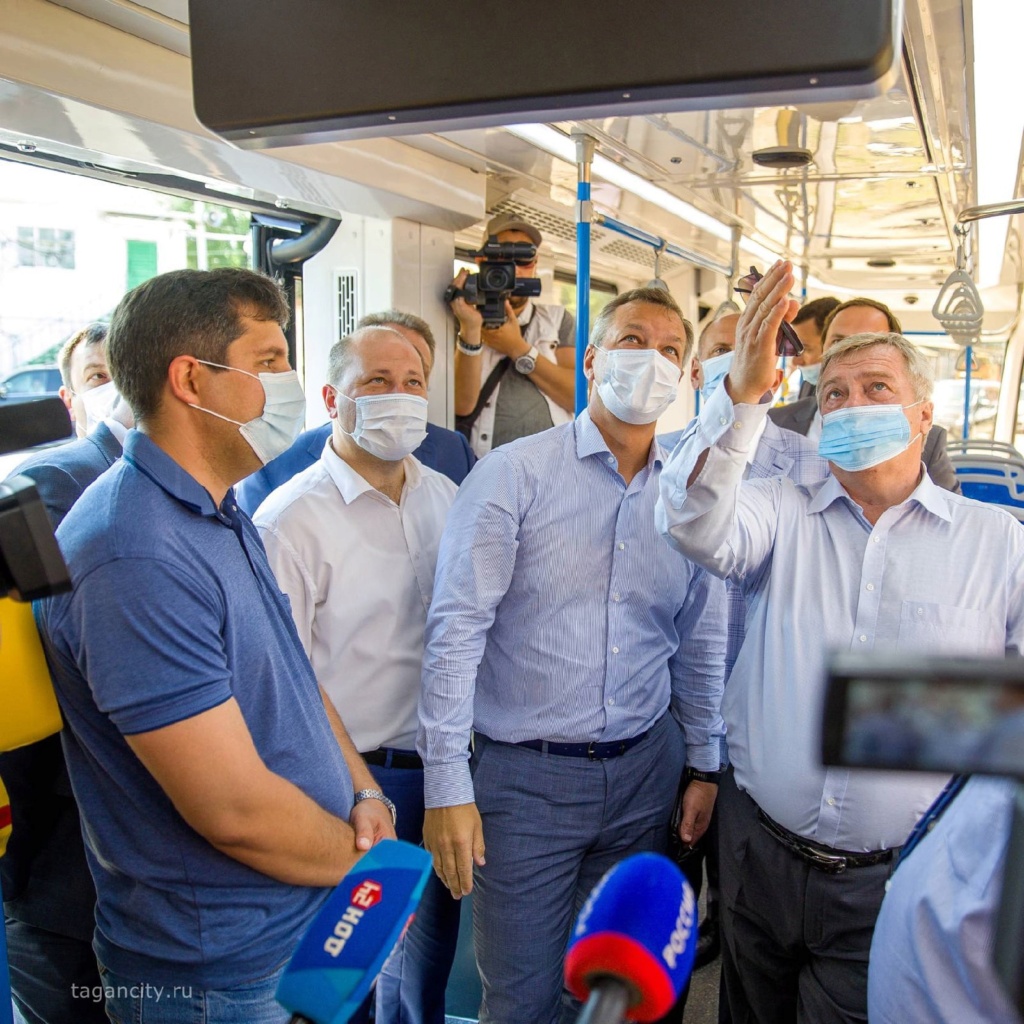
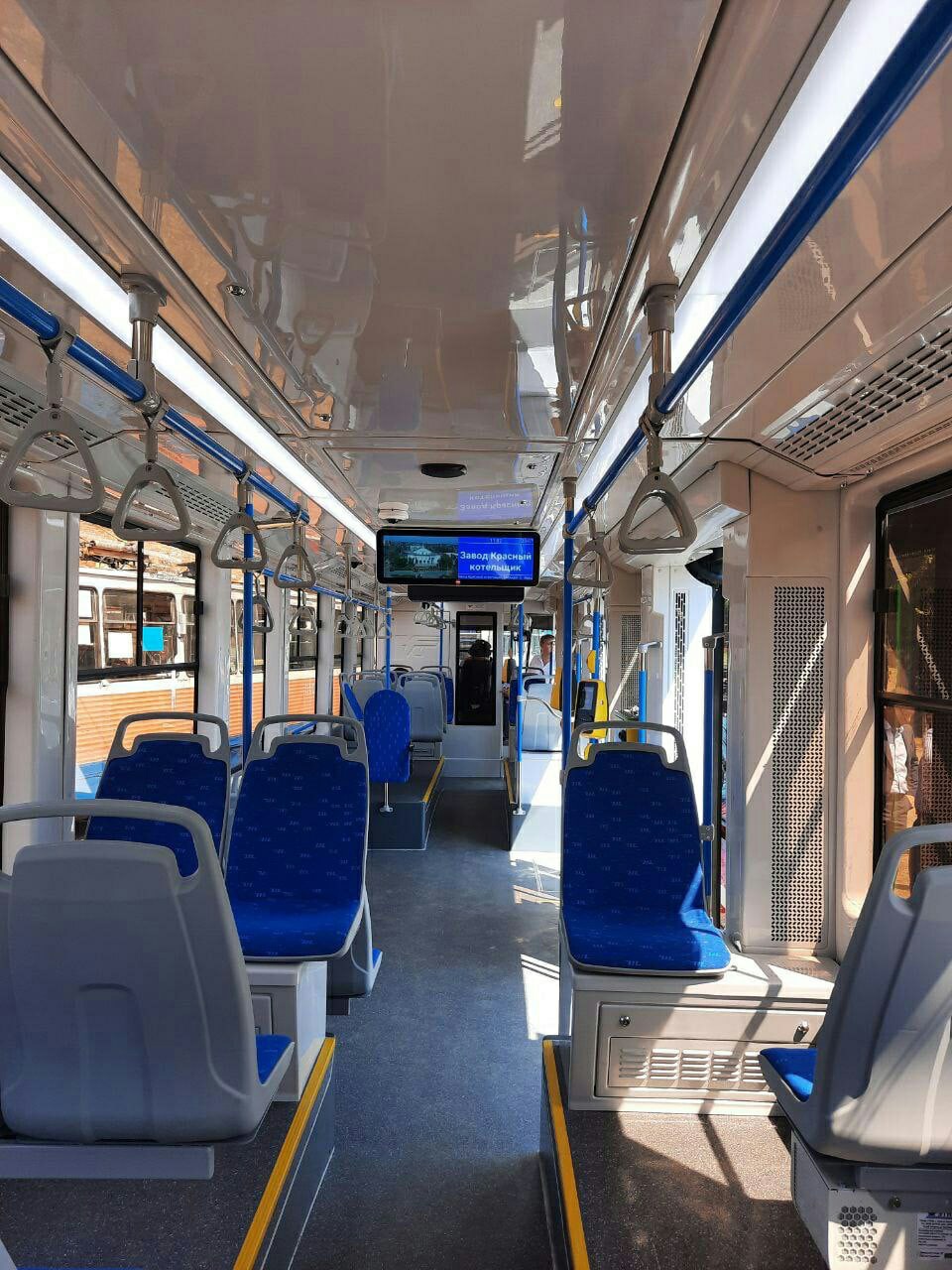
The head of the region appreciated the comfort and convenience of the new tram. The low floor level will provide ease of movement around the cabin, and large doorways and wide aisles between the rows are convenient for moving small groups of passengers and children. It is noteworthy that the tram is equipped with sockets for charging mobile phones. The cabin is equipped with video surveillance cameras, auto-informators, screens with running lines and multimedia screens, as well as climate control systems. There are 33 seats in the tram, and it can accommodate 116 people in total. "The updated public transport will certainly help to increase the attractiveness of Taganrog as a tourist center" – Vasily Golubev said.
As part of the modernization of the tram network Taganrog, which is implemented by the company "Sinara", 60 new trams will come on the line. The first ten will be delivered in September, the remaining 50 will arrive before the end of October 2022.





flamming_python likes this post

Russian_Patriot_- Posts : 1286
Points : 1300
Join date : 2021-06-08
- Post n°21
 Re: Public transport in Russian cities
Re: Public transport in Russian cities
Electric GAZelle already carries passengers.
The entire charging infrastructure is also Russian-made.
In September last year, the Gorky Automobile Plant released pre-production samples of the GAZelle e-NN. Now GAZ Group has announced that two electric buses (with a capacity of up to 17 people) have entered the passenger route that connects Strigino airport and the Park Kultury metro station in Nizhny Novgorod. The launch of the route is timed to coincide with the 800th anniversary of the city.
The GAZelle e-NN is Russia's first light commercial electric vehicle. The model is based on a single electric platform. This architecture can be used to produce flatbed trucks, vans, minibuses, and special equipment.
The GAZelle e-NN has a gross weight of 4.6 t. It is equipped with an electric motor (136 hp and 310 Nm), rechargeable batteries (48 kW / h), a voltage converter, a charger and other components.
The maximum speed of the electric Gazelle is 100 km / h, and the power reserve on a single charge reaches from 120 to 200 km. It is also possible to quickly charge up to 80% of the capacity in 30 minutes.
The cost of GAZelle e-NN is not reported. On-board Gazelle NN in the diesel version, "live" sales of which will start on August 24, costs from 1,899,400 rubles.
Source: https://zr-ru.turbopages.org/zr.ru/s/content/news/930173-gazelle-e-nn/
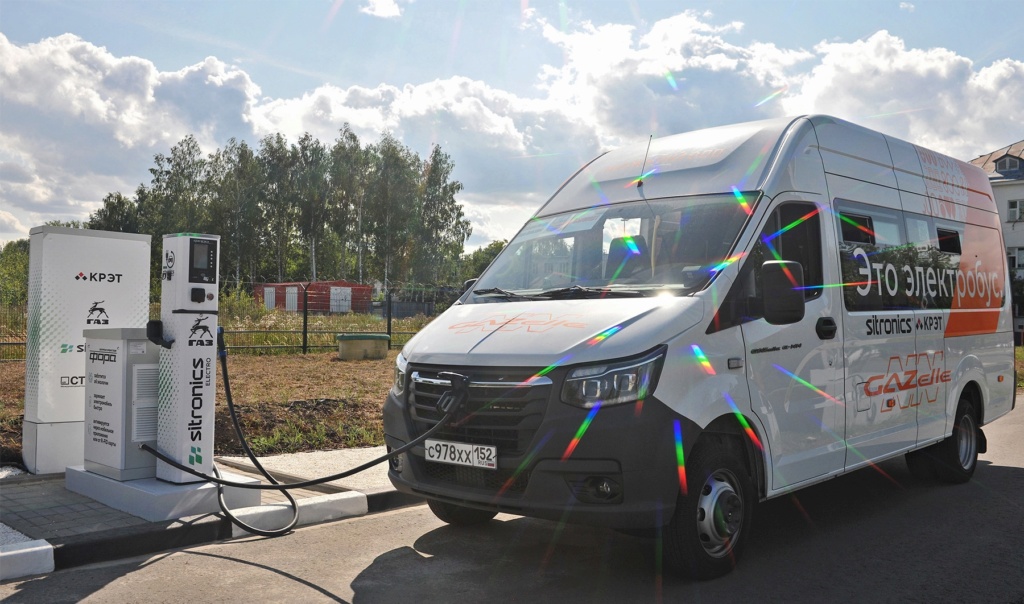
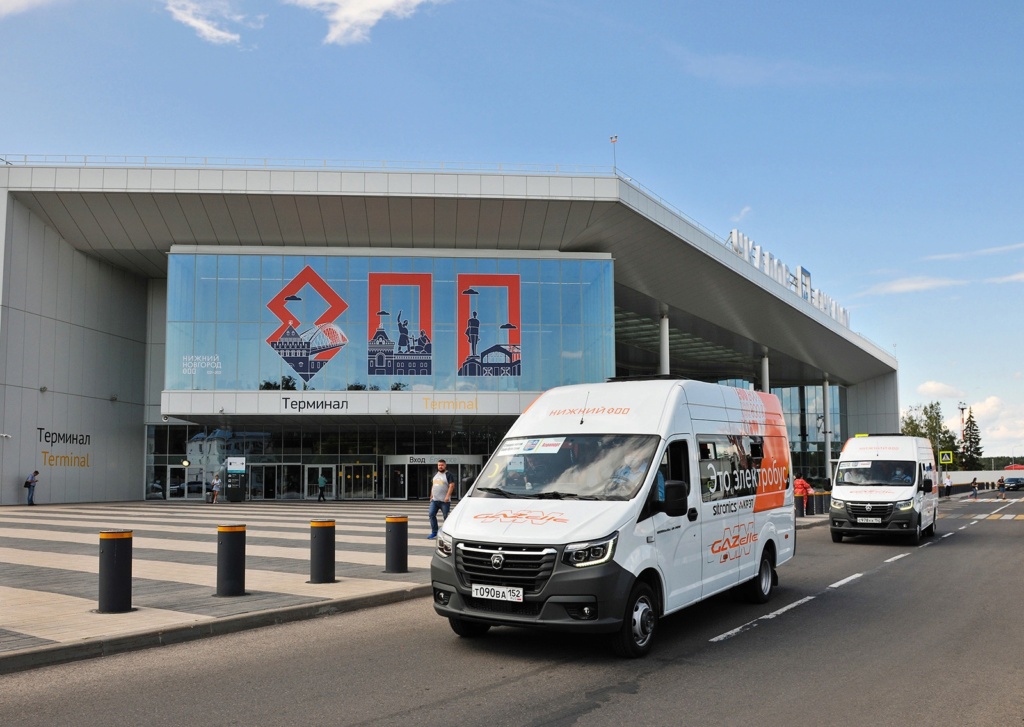
The entire charging infrastructure is also Russian-made.
In September last year, the Gorky Automobile Plant released pre-production samples of the GAZelle e-NN. Now GAZ Group has announced that two electric buses (with a capacity of up to 17 people) have entered the passenger route that connects Strigino airport and the Park Kultury metro station in Nizhny Novgorod. The launch of the route is timed to coincide with the 800th anniversary of the city.
The GAZelle e-NN is Russia's first light commercial electric vehicle. The model is based on a single electric platform. This architecture can be used to produce flatbed trucks, vans, minibuses, and special equipment.
The GAZelle e-NN has a gross weight of 4.6 t. It is equipped with an electric motor (136 hp and 310 Nm), rechargeable batteries (48 kW / h), a voltage converter, a charger and other components.
The maximum speed of the electric Gazelle is 100 km / h, and the power reserve on a single charge reaches from 120 to 200 km. It is also possible to quickly charge up to 80% of the capacity in 30 minutes.
The cost of GAZelle e-NN is not reported. On-board Gazelle NN in the diesel version, "live" sales of which will start on August 24, costs from 1,899,400 rubles.
Source: https://zr-ru.turbopages.org/zr.ru/s/content/news/930173-gazelle-e-nn/


GarryB, PapaDragon and miketheterrible like this post

Russian_Patriot_- Posts : 1286
Points : 1300
Join date : 2021-06-08
- Post n°22
 Re: Public transport in Russian cities
Re: Public transport in Russian cities
flamming_python, dino00 and xeno like this post

Russian_Patriot_- Posts : 1286
Points : 1300
Join date : 2021-06-08
- Post n°23
 Re: Public transport in Russian cities
Re: Public transport in Russian cities
flamming_python likes this post

flamming_python- Posts : 9519
Points : 9577
Join date : 2012-01-30
- Post n°24
 Re: Public transport in Russian cities
Re: Public transport in Russian cities
Russian_Patriot_ likes this post

Russian_Patriot_- Posts : 1286
Points : 1300
Join date : 2021-06-08
- Post n°25



